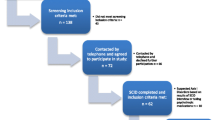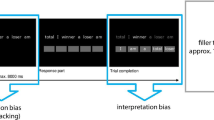Abstract
This investigation studied the presence of a memory bias for words connoting fatness in persons diagnosed with an eating disorder. Eating disorder subjects were compared to a nonsymptomatic control group and to a symptomatic (weight-preoccupied) control group. A memory bias for fatness words in eating disorder patients was found. There was no evidence for a memory bias in either group of control subjects, i.e., those who were preoccupied with body size and shape nor those without extreme preoccupation. The three groups did not differ in the recall of nonfat or neutral words. These results were interpreted as evidence in support of the hypothesis that activating self-schemata in eating disorder patients results in a recall bias for fat-related stimuli.
Similar content being viewed by others
References
American Psychiatric Association. (1987).Diagnostic and statistical manual of mental disorders (3rd ed. rev.). Washington, DC: Author.
Baker, J. D., Williamson, D. A., & Sylve, C. (1995). Body image disturbance, memory bias, and body dysphoria: Effects of negative mood induction.Behavior Therapy 26, 747–760.
Beck, A. T. (1972).Depression: Causes and treatment. Philadelphia: Center for Cognitive Therapy.
Beck, A. T., Ward, C. H., Mendelson, M., Mock, J. E., & Erbaugh, J. K. (1961). An inventory for measuring depression.Archives of General Psychiatry, 4, 561–571.
Ben-Tovim, D. I., Walker, M. K., Fok, D., & Yap, E. (1989). An adaptation of the Stroop test for measuring shape and food concerns in eating disorders: A quantitative measure of psychopathology?International Journal of Eating Disorders, 8, 681–687.
Bower, G. H. (1981). Mood and memory.American Psychologist, 36, 129–148.
Butler, D. L. (1988). A critical evaluation of software for experiment development in research and teaching.Behavior Research Methods, Instruments and Computers, 20, 218–220.
Channon, S., Hemsley, D., & de Silva, P. (1988). Selective processing of food words in anorexia nervosa.British Journal of Clinical Psychology, 27, 259–260.
Cooper, P. J., Anastasiades, P., & Fairburn, C. G. (1992). Selective processing of eating, shape, and weight related words in persons with bulimia nervosa.Journal of Abnormal Psychology, 101, 352–355.
Cooper, P. J., Taylor, M. J., Cooper, Z., & Fairburn, C. G. (1987). The development and validation of the Body Shape Questionnaire.International Journal of Eating Disorders, 6, 485–494.
Dahl, H. (1979).Word frequencies of spoken American English. Detroit: Averbatim Books.
Eysenck, H. J., & Eysenck, S. B. G. (1963).Eysenck Personality Inventory. San Diego: Educational and Industrial Testing Service.
Fairburn, C. G., Cooper, P. J., Cooper, M. J., McKenna, F. P., & Anastasiades, P. (1991). Selective information processing in bulimia nervosa.International Journal of Eating Disorders, 10, 415–422.
Garner, D. M., & Garfinkel, P. E. (1979). The eating attitudes test: An index of the symptoms of anorexia nervosa.Psychological Medicine, 9, 273–279.
Haaga, D. A. F., Dyck, M. J., & Ernst, D. (1991). Empirical status of cognitive theory of depression.Psychological Bulletin, 110, 215–236.
King, G. A., Polivy, J., & Herman, C. P. (1991). Cognitive aspects of dietary restraint: Effects on person memory.International Journal of Eating Disorders, 10, 313–321.
Markus, H., Hamill, R., & Sentis, K. P. (1987). Thinking fat: Self-schemas for body weight and the processing of weight relevant information.Journal of Applied Social Psychology, 17, 50–71.
Prado, W. M., & Taub, D. V. (1966). Accurate prediction of individual intellectual functioning by the Shipley-Hartford.Journal of Clinical Psychology, 22, 294–296.
Schneider, W. (1988). Micro Experimental Laboratory: An integrated system for IBM PC compatibles.Behavior Research Methods, Instruments and Computers, 20, 206–217.
Schotte, D. E., McNally, R. J., & Turner, M. L. (1990). A dichotic listening analysis of body weight concerns in bulimia nervosa.International Journal of Eating Disorders, 9, 109–113.
Smith, M. C., & Thelen, M. H. (1984). Development and validation of a test for bulimia.Journal of Consulting and Clinical Psychology, 52, 863–872.
Stroop, J. R. (1935). Studies of interference in serial verbal reactions.Journal of Experimental Psychology, 18, 643–661.
Strupp, B. J., Weingartner, H., Kaye, W., & Gwirtsman, H. (1986). Cognitive processing in anorexia nervosa.Neuropsychobiology, 15, 89–94.
Vitousek, K. B., & Hollon, S. D. (1990). The investigation of schematic content and processing in eating disorders.Cognitive Therapy and Research, 14, 191–214.
Williams, J. M. G., Watts, F. N., MacLeod, C., & Mathews, A. (1988).Cognitive psychology and emotional disorders. Chichester, England: John Wiley & Sons.
Williamson, D. A. (1990).Assessment of eating disorders: Obesity, anorexia, and bulimia nervosa. New York: Pergamon Press.
Williamson, D. A., Barker, S. E., & Norris, L. E. (1993). Etiology and management of eating disorders. In P. B. Sutker & H. E. Adams (Eds.),Comprehensive handbook of psychopathology (2nd ed., pp. 505–530). New York: Plenum Press.
Williamson, D. A., Davis, C. J., Norris, L., & Van Buren, D. J. (1990, November).Development of reliability and validity for a new structured interview for diagnosis of eating disorders. Paper presented at the annual meeting of the Association for the Advancement of Behavior Therapy, San Francisco.
Author information
Authors and Affiliations
Additional information
This article is based on the doctoral dissertation of Shannon B. Sebastian (1993). Portions of this article were presented at the annual convention of the Association for the Advancement of Behavior Therapy, Atlanta, November 1993.
Rights and permissions
About this article
Cite this article
Sebastian, S.B., Williamson, D.A. & Blouin, D.C. Memory bias for fatness stimuli in the eating disorders. Cogn Ther Res 20, 275–286 (1996). https://doi.org/10.1007/BF02229238
Issue Date:
DOI: https://doi.org/10.1007/BF02229238




